 loading
loading
featuresHigh ImpactThe environment school's new building seeks to be self-effacing in terms of its carbon footprint. But as a home for the school and an improvement to Science Hill, it makes a big impression. Mark Alden Branch ’86 is executive editor of the Yale Alumni Magazine. 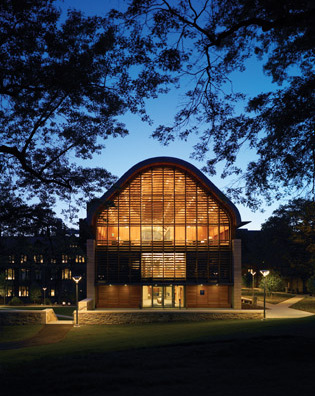 Christopher GardnerWood louvers on both ends of the building help control the east and west sun but permit dramatic views of West Rock and Ingalls Rink in one direction and Sachem's Wood in the other. View full imageMuch of the advance buzz about Kroon Hall, the new headquarters of the School of Forestry & Environmental Studies, was about the green features that would minimize its energy use and carbon footprint. But since Kroon was completed last spring, users and visitors have encountered a building that is more conspicuous for its aesthetics and hospitality than for its miserly energy use. Kroon, located on Prospect Street between Osborn Memorial Laboratories and Sage Hall, was conceived as an exemplar of environmentally conscious design, a way for the environment school to “walk the talk” about sustainability, according to Professor Stephen Kellert ’71PhD, who helped inspire the project more than a decade ago. As designed by the British firm Hopkins Architects with Centerbrook Architects and Planners of Connecticut, the building is a showcase both for the newest green technology (photovoltaic panels to generate electricity, geothermal wells for heating and cooling, rainwater recycling) and for timeless but underused sustainable-building techniques (generous use of daylight, stone and concrete masses to help regulate and retain heat). The architects say they expect Kroon to be responsible for 540 metric tons of greenhouse gases per year, 62 percent less than a conventional building. The school will buy offsets -- carbon savings, available by the ton through investments in, for example, wind energy -- to cover the rest and make the building effectively carbon-neutral. Yale facilities officials say it'll take at least a year of “fine-tuning” before they can begin to assess its energy performance. But the people who work in Kroon give it good reviews for reasons that have little to do with the largely invisible green features. After being spread out in nine buildings, environment school faculty, staff, and students are happy to be mostly under one roof. “We're kind of a university within a university in the sense that we have an incredible number of disciplines represented on our faculty, so it is all the more important that people are interacting with one another spontaneously,” says Kellert. “I was surprised what a difference a building can make in your outlook on coming to work every day,” says Amity Doolittle ’99PhD, a lecturer and research scientist at the school. “It's been really huge in terms of bringing faculty together.” Students, too, are frequenting the building, especially the vaulted public spaces on the top floor that have become a kind of living room for the school. “Every time I was there this spring there would be dozens of students either studying or socializing,” says Professor Gaboury Benoit ’76. Besides what it has done for the environment school, the Kroon Hall project has also improved the environment of Science Hill, whose landscape has never received the level of attention lavished on the central campus. The site where Kroon stands once housed a most ungreen power plant and a network of loading docks, pipes, and utility lines. As part of the project, the loading docks were reorganized underground, beneath a new courtyard. The corner walkway through Osborn, which once led nowhere, now takes pedestrians through the courtyard and up Science Hill. Further landscaping improvements are planned for Sachem's Wood, the open space between Kroon and the Peabody Museum. So far, complaints about the building are few. Benoit says electrical outlets are not well placed, and not everyone is happy about a system that tells people (via green or yellow signal lights placed throughout the building) when they can open their office windows. And Kellert regrets that, while the wood-paneled, light-filled top floor is “extraordinary,” budget cuts reduced the three office floors to “good but not great.” The building has mostly been praised by architecture critics. James Russell wrote for Bloomberg News that the building “snuggles gracefully amid stone-faced neo-Gothic neighbors. Its front-door plaza unites adjacent forestry buildings into a handsome ensemble.” In the Hartford Courant, Philip Langdon wrote that Kroon “pleases the senses” and that its top floor is “one of Yale's best recent interiors -- spacious, even grand, without being overwhelming.” But Langdon and others have questioned the choice of light-colored sandstone for the exterior. Although the sandstone used on Kroon is the same stone used on many central campus buildings, Science Hill is dominated by dark red and brown stone. Langdon says the stone used for Kroon “undercuts the aesthetic unity of Science Hill.” As for the building's energy performance, we'll just have to wait and see. But Kellert is already hedging a little about whether the estimates will prove accurate -- for reasons the planners didn't foresee. Kellert says students and faculty like the building so much they're spending a lot of time there, using the lights and their computers. “The ironic thing is that because the building is so popular, we may end up using more energy than anticipated.” 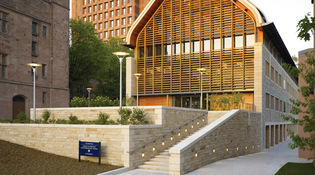 Christopher GardnerThe Prospect Street entrance to Kroon Hall is set on a raised plaza that disguises pipes and mechanical equipment left over from when the site housed a power plant. View full image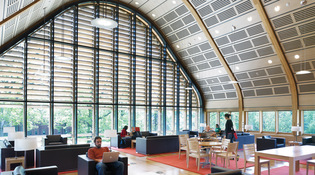 Christopher GardnerThe Knobloch Environment Center on Kroon's top floor was conceived as a kind of living room for the school. View full image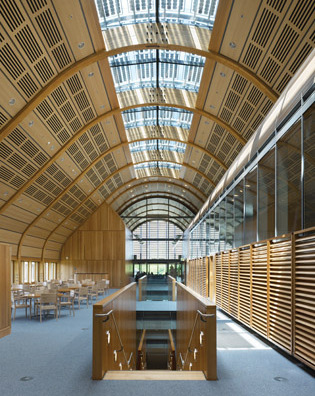 Christopher GardnerSkylights running along the crest of the vaulted ceiling bring in light and offer a glimpse of the electricity-generating photovoltaic panels on the roof. View full image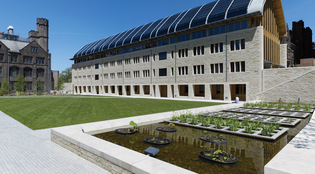 Christopher GardnerIn a new courtyard bordered by Kroon and by Osborn Memorial Laboratories, a shallow pond filled with plants cleanses rainwater for use in toilets and for irrigation. View full image
The comment period has expired.
|
|